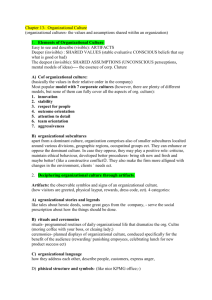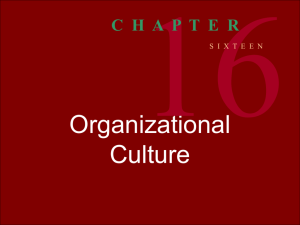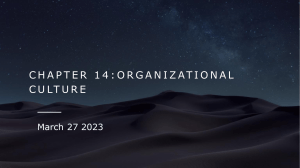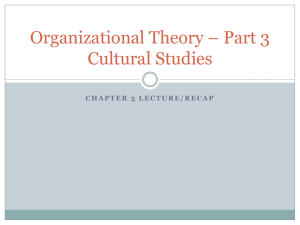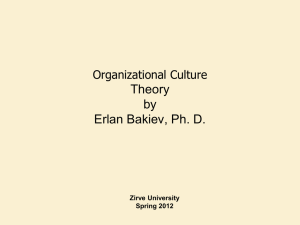Chapter 16 Organizational Culture
advertisement
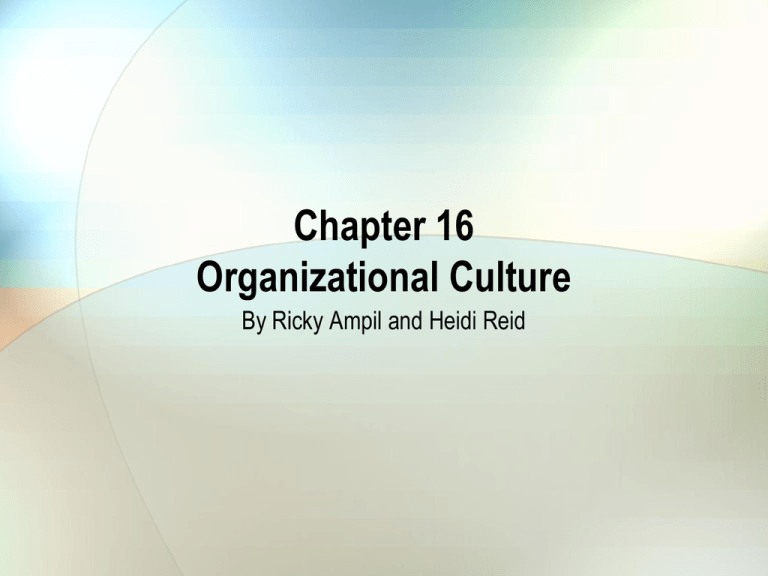
Chapter 16 Organizational Culture By Ricky Ampil and Heidi Reid Overview • Describe the elements of organizational culture • Discuss the importance of organizational subcultures • List 4 categories of artifacts through which corporate culture is deciphered • Identify 3 functions of organizational subcultures • Discuss the conditions under which cultural strength improves corporate performance • Compare and contrast 4 strategies for merging organizational cultures • Identify 4 strategies to strengthen an organization’s culture • Describe the stages of organizational socialization Introduction • Organizational Culture • Values and assumptions shared within an organization • 3 Elements of Organizational Culture • Visible Element – Artifacts • Invisible Elements – Shared Values and Shared Assumptions Organizational Subcultures • Organizational Culture refers to the “dominant culture” • Beneath the surface exists Subcultures • Classified by division, geographic, and occupational groups • Enhance dominant culture • Includes countercultures which go against the grain • 2 Functions of Subcultures • Maintain standards of performance and ethical behavior • Spawning ground for emerging values that ensure a company adapts to growing trends in the marketplace Artifacts • Observable symbols and signs of existing culture • Example: Pixar • 4 Types of Artifacts • • • • Organizational Stories and Legends Rituals and Ceremonies Organizational Language Physical Structures and Symbols The Importance of Organizational Culture • 3 Functions • Control System • Social Glue • Sense-making • Strong cultures must be aligned with the company’s environment to succeed Contingencies and Performance • Strong cultures are potentially good… but: • Overall weak relationship between cultural strength and success • Cultural strength equates to strong individual identity which causes conflict in decision making • Strength also forms decision makers into a strict mold with no room for adapting to new/different methods • Dissenting subcultural values are smothered rather than promoted Adaptive Culture • Focus on the changing needs of customers, stakeholders, and support initiatives to keep pace with those changes • Possesses an external focus as opposed to internal • Within an adaptive culture, employees pay equal attention to organizational processes and organizational goals • Strong sense of ownership (Example: New Belgium Brewery) • Organizations are more likely to succeed when they utilize an adaptive culture Merging Organizational Cultures • Bicultural Audit • A diagnosis of cultural relations between companies prior to a merger and a determination of the extent to which cultural clashes are likely to occur • In some cases a bicultural audit will result in a decision to end merger talks because the two cultures are too different to merge effectively Strategies to Merge Different Cultures Assimilation • Occurs when employees at the acquired company willingly embrace the cultural values of the acquiring organization Deculturation • The acquiring company imposes their culture and business practices on the acquired company Integration • Combine cultures into a new composite culture that preserves the best features of the previous cultures Separation • Occurs if the merging companies agree to remain distinct entities with minimal exchange of culture or organizational practices Strategies to Change and Strengthen Org Culture Actions of Founders and Leaders • Symbolize the new culture through memorable events • Model the new culture through subtle decisions and actions Culturally Consistent Rewards • Reward employees for culturally consistent behaviors • Reward managers who help employees understand the culture Strategies to Change and Strengthen Culture-cont’d Selecting and Socializing Employees • Hire people whose values are consistent with the culture • Inform and indoctrinate new staff about what the culture means Aligning Artifacts • Share stories supporting the culture • Celebrate goals and milestones to support the culture • Inhabit buildings that reflect the culture Organization Socialization Organization Socialization • The process by which individuals learn the values, expected behaviors, and social knowledge necessary to assume their roles in the organization • The process of adjustment because the individuals need to adapt to their new work environment Stages of Socialization Pre-employment Socialization • Learn about the organization and job • Form employment relationship expectations Encounter • Test expectations against perceived realities • Reality Shock-perceived discrepancies between preemployment expectations and on-the-job reality Role Management • Strengthen work relationships • Practice new role behaviors • Resolve work and non-work conflicts Socialization Outcomes • • • • • Higher motivations Higher loyalty Higher satisfaction Lower stress Lower turnover Q&A • 1) How many elements make up Organizational Culture? • • • • • • • • A) 2 B) 3 C) 4 D) 5 2) What are the groups that exist beneath the dominant culture referred to as? 3) T/F – A bicultural audit always integrates two dominant cultures. 4) T/F – Culturally consistent rewards help to strengthen an organizational culture 5) Which of the following is not a positive outcome of organizational socialization? • • • • A) Higher Motivation B) Higher Loyalty C) Lower Stress D) Higher Turnover

